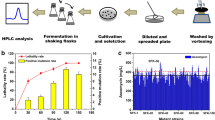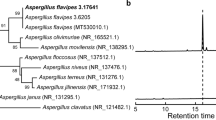Abstract
Combinatorial approach of adsorbent resin HP20 addition and metabolic profiling analysis were carried out to enhance ascomycin production. Under the optimal condition of 5 % m/v HP20 added at 24 h, ascomycin production was increased to 380 from 300 mg/L. To further rationally guide the improvement of ascomycin production, metabolic profiling analysis was employed to investigate the intracellular metabolite changes of Streptomyces hygroscopicus var. ascomyceticus FS35 in response to HP20 addition. A correlation between the metabolic profiles and ascomycin accumulation was revealed by partial least-squares to latent structures discriminant analysis, and 11 key metabolites that most contributed to metabolism differences and ascomycin biosynthesis were identified. Based on the analysis of metabolite changes together with their pathways, the potential key factors associated with ascomycin overproduction were determined. Finally, rationally designed fermentation strategies based on HP20 addition were performed as follows: 2 % v/v n-hexadecane was added at 24 h; 1.0 g/L valine was supplemented at 48 h; 1.0 g/L lysine was added at 72 h. The ascomycin production was ultimately improved to 460 mg/L, a 53.3 % enhancement compared with that obtained in initial condition. These results demonstrated that the combination of HP20 addition and metabolic profiling analysis could be successfully applied to the rational guidance of production improvement of ascomycin, as well as other clinically important compounds.




Similar content being viewed by others
References
Amaral PFF, Freire MG, Rocha-Leão MHM, Marrucho IM, Coutinho JAP, Coelho MAZ (2008) Optimization of oxygen mass transfer in a multiphase bioreactor with perfluorodecalin as a second liquid phase. Biotechnol Bioeng 99:588–598
Andexer JN, Kendrew SG, Nur-e-Alam M, Lazos O, Foster TA, Zimmermann AS, Warneck TD, Suthar D, Coates NJ, Koehn FE, Skotnicki JS, Carter GT, Gregory MA, Martin CJ, Moss SJ, Leadlay PF, Wilkinson B (2011) Biosynthesis of the immunosuppressants FK506, FK520, and rapamycin involves a previously undescribed family of enzymes acting on chorismate. Proc Natl Acad Sci USA 108:4776–4781
Bayer E, Bauer B, Eggerer H (1981) Evidence from inhibitor studies for conformational changes of citrate synthase. Eur J Biochem 120:155–160
Boone B, Ongenae K, Van Geel N, Vernijns S, De Keyser S, Naeyaert JM (2007) Topical pimecrolimus in the treatment of vitiligo. Eur J Dermatol 17:55–61
Calik P, Yilgor P, Ayhan P, Demir AS (2004) Oxygen transfer effects on recombinant benzaldehyde lyase production. Chem Eng Sci 59:5075–5083
Celler K, Picioreanu C, van Loosdrecht MCM, van Wezel GP (2012) Structured morphological modeling as a framework for rational strain design of Streptomyces species. Antonie Van Leeuwenhoek 102:409–423
De Graef MR, Alexeeva S, DeSnoep JL, Mattos MJTd (1999) The steady-state internal redox state (NADH/NAD) reflects the external redox state and is correlated with catabolic adaptation in Escherichia coli. J Bacteriol 181:2351–2357
Dietmair S, Hodson MP, Quek LE, Timmins NE, Chrysanthopoulos P, Jacob SS, Gray P, Nielsen LK (2012) Metabolite profiling of CHO cells with different growth characteristics. Biotechnol Bioeng 109:1404–1414
Dumont FJ, Staruch MJ, Koprak SL, Siekierka JJ, Lin S, Harrison R, Sewell T, Kindt VM, Beattie T, Wyvratt M (1992) The immunosuppressive and toxic effects of FK-506 are mechanistically related: pharmacology of a novel antagonist of FK-506 and rapamycin. J Exp Med 176:751–760
Fazenda ML, Harvey LM, McNeil B (2010) Effects of dissolved oxygen on fungal morphology and process rheology during fed-batch processing of Ganoderma lucidum. J Microbiol Biotechnol 20:844–851
Firooz A, Solhpour A, Gorouhi F, Daneshpazhooh M, Balighi K, Farsinejad K, Rashighi-Firoozabadi M, Dowlati Y (2006) Pimecrolimus cream, 1%, vs hydrocortisone acetate cream, 1%, in the treatment of facial seborrheic dermatitis: a randomized, investigator-blind, clinical trial. Arch Dermatol 142:1066–1067
Foster JW, Park YK, Penfound T, Fenger T, Spector MP (1990) Regulation of NAD metabolism in Salmonella typhimurium: molecular sequence analysis of the bifunctional nadR regulator and the nadA-pnuC operon. J Bacteriol 172:4187–4196
Jacobi A, Braeutigam M, Mahler V, Schultz E, Hertl M (2008) Pimecrolimus 1 % cream in the treatment of facial psoriasis: a 16-week open-label study. Dermatology 216:133–136
Kirdar AO, Green FD, Rathore AS (2008) Application of multivariate data analysis for identification and successful resolution of a root cause for a bioprocessing application. Biotechnol Prog 24:720–726
Korneli C, Bolten CJ, Godard T, Franco-Lara E, Wittmann C (2012) Debottlenecking recombinant protein production in Bacillus megaterium under large-scale conditions—targeted precursor feeding designed from metabolomics. Biotechnol Bioeng 109:1538–1550
Li MH, Meng XM, Diao EJ, Du FL, Zhao XY (2012) Productivity enhancement of S-adenosylmethionine in Saccharomyces cerevisiae using n-hexadecane as oxygen vector. J Chem Technol Biotechnol 87:1379–1384
Liu B, Hui J, Cheng YQ, Zhang X (2012) Extractive fermentation for enhanced production of thailandepsin A from Burkhoderia thailandensis E264 using polyaromatic adsorbent resin Diaion HP20. J Ind Microbiol Biotechnol 39:767–776
Lu SH, Wang JX, Niu YH, Yang J, Zhou J, Yuan YJ (2012) Metabolic profiling reveals growth related FAME productivity and quality of Chlorella sorokiniana with different inoculum sizes. Biotechnol Bioeng 109:1651–1662
Madden T, Ward JM, Ison AP (1996) Organic acid excretion by Streptomyces lividans TK24 during growth on defined carbon and nitrogen sources. Microbiology 142:3181–3185
Olmos E, Mehmood N, Haj Husein L, Goergen JL, Fick M, Delaunay S (2013) Effects of bioreactor hydrodynamics on the physiology of Streptomyces. Bioprocess Biosyst Eng 36:259–272
O’Sullivan E, Condon S (1999) Relationship between acid tolerance, cytoplasmic pH, and ATP and H+-ATPase levels in chemostat cultures of Lactococcus lactis. Appl Environ Microbiol 65:2287–2293
Parveen K, Kumar SS, Kumar MH (2007) An improved fermentation process for preparing ascomycin. WO 2007/029082
Paul M, Maria F, Revill WP (2005) Antimalarial effects of macrolactones related to FK520 (Ascomycin) are independent of the immunosuppressive properties. J Infect Dis 191:1342–1349
Phillips T, Chase M, Wagner S, Renzi C, Powell M, DeAngelo J, Michels P (2013) Use of in situ solid-phase adsorption in microbial natural product fermentation development. J Ind Microbiol Biotechnol 40:411–425
Qi HS, Xin X, Li SS, Wen JP, Chen YL, Jia XQ (2012) Higher-level production of ascomycin (FK520) by Streptomyces hygroscopicus var. ascomyceticus irradiated by femtosecond laser. Biotechnol Bioprocess Eng 17:770–779
Qi HS, Zhao SM, Wen JP, Chen YL, Jia XQ (2014) Analysis of ascomycin production enhanced by shikimic acid resistance and addition in Streptomyces hygroscopicus var. ascomyceticus. Biochem Eng J 82:124–133
Regentin R, Cadapan L, Ou S, Zavala S, Licari P (2002) Production of a novel FK520 analog in Streptomyces hygroscopicus: improving titer while minimizing impurities. J Ind Microbiol Biotechnol 28:12–16
Revill WP, Voda J, Reeves CR, Chung L, Schirmer A, Ashley G, Carney JR, Fardis M, Carreras CW, Zhou Y, Feng L, Tucker E, Robinson D, Gold BG (2002) Genetically engineered analogs of ascomycin for nerve regeneration. J Pharmacol Exp Ther 302:1278–1285
Rols JL, Condoret JS, Fonade C, Gome G (1990) Mechanism of enhanced oxygen transfer in fermentation using emulsified oxygen-vectors. Biotechnol Bioeng 35:427–435
Selvarasu S, Ho YS, Chong WP, Wong NS, Yusufi FN, Lee YY, Yap MG, Lee DY (2012) Combined in silico modeling and metabolomics analysis to characterize fed-batch CHO cell culture. Biotechnol Bioeng 109:1415–1429
Sierra PG, Sierra MG (2008) Ascomycin and FK506: pharmacology and therapeutic potential as anticonvulsants and neuroprotectants. CNS Neurosci Ther 14:36–46
Singh MP, Leighton MM, Barbieri LR, Roll DM, Urbance SE, Hoshan L, McDonald LA (2010) Fermentative production of self toxic fungal secondary metabolites. J Ind Microbiol Biotechnol 37:335–340
Stirrett K, Denoya C, Westpheling J (2009) Branched-chain amino acid catabolism provides precursors for the Type II polyketide antibiotic, actinorhodin, via pathways that are nutrient dependent. J Ind Microbiol Biotechnol 36:129–137
Wang GY, Huang D, Qi HS, Wen JP, Jia XQ, Chen YL (2013) Rational medium optimization based on comparative metabolic profiling analysis to improve fumaric acid production. Bioresour Technol 137:1–8
Wu K, Chung L, Revill WP, Katz L, Reeves CD (2000) The FK520 gene cluster of Streptomyces hygroscopicus var. ascomyceticus (ATCC 14891) contains genes for biosynthesis of unusual polyketide extender units. Gene 251:81–90
Xia ML, Huang D, Li SS, Wen JP, Jia XQ, Chen YL (2013) Enhanced FK506 production in Streptomyces tsukubaensis by rational feeding strategies based on comparative metabolic profiling analysis. Biotechnol Bioeng 110:2717–2730
Yin P, Wang YH, Zhang SL, Chu J, Zhuang YP, Chen N, Li XF, Wu YB (2008) Effect of mycelial morphology on bioreactor performance and avermectin production of Streptomyces avermitilis in submerged cultivations. J Chin Inst Chem Eng 39:609–615
Zaunmuller T, Eichert M, Richter H, Unden G (2006) Variations in the energy metabolism of biotechnologically relevant heterofermentative lactic acid bacteria during growth on sugars and organic acids. Appl Microbiol Biotechnol 72:421–429
Zhao SM, Huang D, Qi HS, Wen JP, Jia XQ (2013) Comparative metabolic profiling-based improvement of rapamycin production by Streptomyces hygroscopicus. Appl Microbiol Biotechnol 97:5329–5341
Zou S, Du E, Hu Z, Zheng Y (2013) Enhanced biotransformation of 1,3-dichloro-2-propanol to epichlorohydrin via resin-based in situ product removal process. Biotechnol Lett 35:937–942
Acknowledgments
This research was financially supported by the National 973 Project of China (No. 2013CB733600), the Key Program of National Natural Science Foundation of China (No. 21236005), Natural Science Foundation of Tianjin (No. 12JCZDJC21900) and the Program of Introducing Talents of Discipline to Universities (No. B06006).
Author information
Authors and Affiliations
Corresponding author
Electronic supplementary material
Below is the link to the electronic supplementary material.
Rights and permissions
About this article
Cite this article
Qi, H., Zhao, S., Fu, H. et al. Enhancement of ascomycin production in Streptomyces hygroscopicus var. ascomyceticus by combining resin HP20 addition and metabolic profiling analysis. J Ind Microbiol Biotechnol 41, 1365–1374 (2014). https://doi.org/10.1007/s10295-014-1473-9
Received:
Accepted:
Published:
Issue Date:
DOI: https://doi.org/10.1007/s10295-014-1473-9




